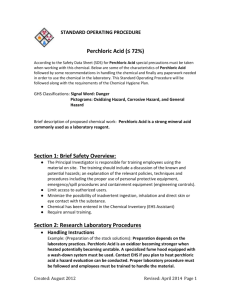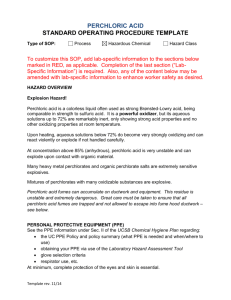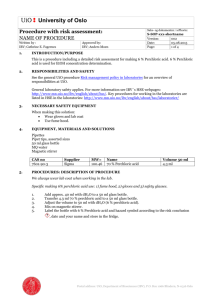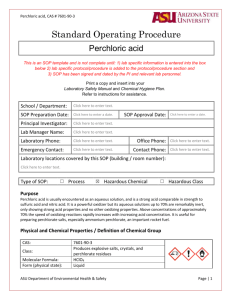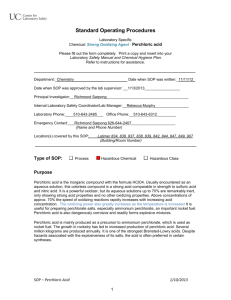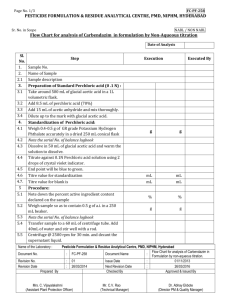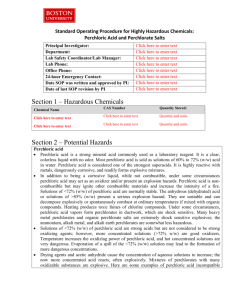Perchloric Acid
advertisement
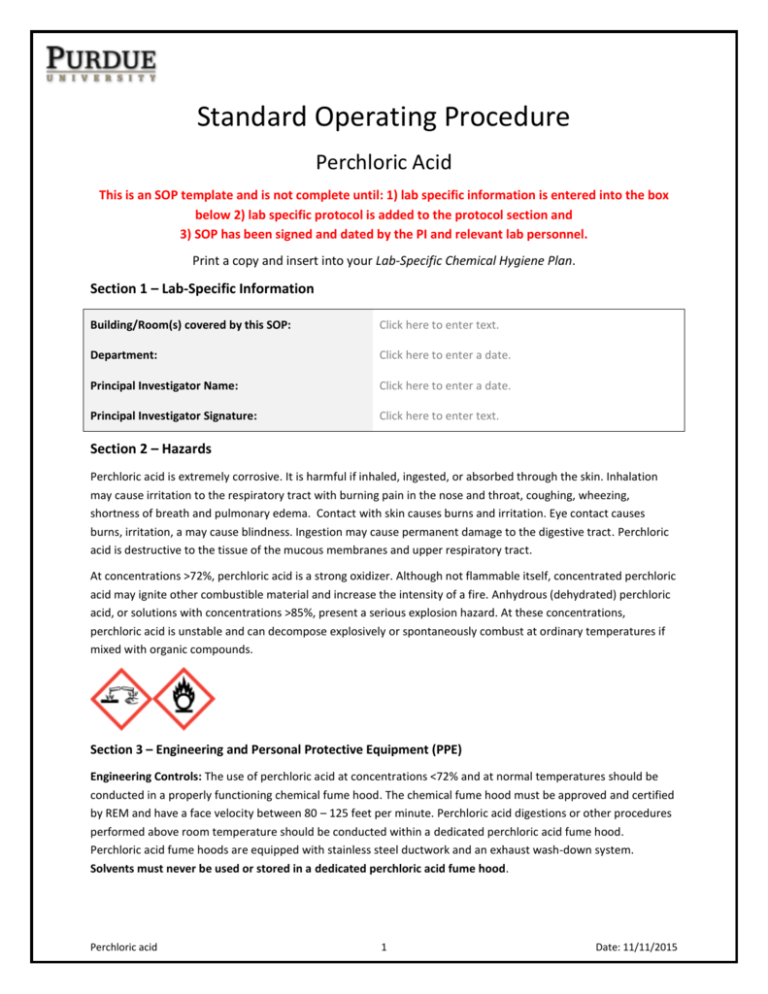
Standard Operating Procedure Perchloric Acid This is an SOP template and is not complete until: 1) lab specific information is entered into the box below 2) lab specific protocol is added to the protocol section and 3) SOP has been signed and dated by the PI and relevant lab personnel. Print a copy and insert into your Lab-Specific Chemical Hygiene Plan. Section 1 – Lab-Specific Information Building/Room(s) covered by this SOP: Click here to enter text. Department: Click here to enter a date. Principal Investigator Name: Click here to enter a date. Principal Investigator Signature: Click here to enter text. Section 2 – Hazards Perchloric acid is extremely corrosive. It is harmful if inhaled, ingested, or absorbed through the skin. Inhalation may cause irritation to the respiratory tract with burning pain in the nose and throat, coughing, wheezing, shortness of breath and pulmonary edema. Contact with skin causes burns and irritation. Eye contact causes burns, irritation, a may cause blindness. Ingestion may cause permanent damage to the digestive tract. Perchloric acid is destructive to the tissue of the mucous membranes and upper respiratory tract. At concentrations >72%, perchloric acid is a strong oxidizer. Although not flammable itself, concentrated perchloric acid may ignite other combustible material and increase the intensity of a fire. Anhydrous (dehydrated) perchloric acid, or solutions with concentrations >85%, present a serious explosion hazard. At these concentrations, perchloric acid is unstable and can decompose explosively or spontaneously combust at ordinary temperatures if mixed with organic compounds. Section 3 – Engineering and Personal Protective Equipment (PPE) Engineering Controls: The use of perchloric acid at concentrations <72% and at normal temperatures should be conducted in a properly functioning chemical fume hood. The chemical fume hood must be approved and certified by REM and have a face velocity between 80 – 125 feet per minute. Perchloric acid digestions or other procedures performed above room temperature should be conducted within a dedicated perchloric acid fume hood. Perchloric acid fume hoods are equipped with stainless steel ductwork and an exhaust wash-down system. Solvents must never be used or stored in a dedicated perchloric acid fume hood. Perchloric acid 1 Date: 11/11/2015 Hygiene Measures: Avoid contact with skin, eyes, and clothing. Wash hands before breaks and immediately after handling perchloric acid. Hand Protection: Two-sets of chemical-resistant gloves (e.g., nitrile) should be worn (“double-gloving”). A heavyduty glove, such as butyl rubber, Viton, or equivalent, is recommended. NOTE: Consult with your preferred glove manufacturer to ensure that the gloves you plan on using are compatible with the specific chemical being used. Eye Protection: ANSI-approved properly fitting safety glasses or chemical splash goggles are required. A face shield must also be worn. Skin and Body Protection: Laboratory coats must be worn and be appropriately sized for the individual and buttoned to their full length. A chemical-resistant apron is also required. Personnel must also wear full length pants, or equivalent, and close-toed shoes. Full length pants and close-toed shoes must be worn at all times by all individuals that are occupying the laboratory area. The area of skin between the shoe and ankle must not be exposed. Respiratory Protection: Perchloric acid should never be used outside of a chemical fume hood; however, if perchloric acid must be used outside of a chemical fume hood, respiratory protection may be required. If this activity is necessary, contact REM (49-46371) so a respiratory protection analysis can be performed. Section 4 – Special Handling and Storage Requirements Do not over purchase; only a minimum amount of perchloric acid should be stored in the laboratory. Avoid contact with skin and eyes. Avoid inhalation of vapor or mist. Avoid formation of dust (explosion hazard!). Always use inside a properly functioning chemical fume hood. Note: In case you need to dilute the concentration of perchloric acid, always add acid to water. Keep container upright and tightly closed in a dry and well-ventilated place. Containers which are opened must be carefully resealed and kept upright to prevent leakage. Date all opened perchloric acid containers. Keep away from sources of ignition. Avoid heat and shock or friction when handling. Store in original container and inside proper secondary containment made of glass or porcelain. Perchloric acid should not be stored in metal or plastic containers. Keep away from incompatible materials: acetic acid, acetic anhydride, alcohols, aniline, bismuth, combustible material, dehydrating agents, hydrochloric acid, organic chemicals, and oxidizers. As such, perchloric acid should be stored away from these chemicals, as well as wood or paper, within a steel cabinet, if possible. Use in the smallest practical quantities for the experiment being performed. Containers should be inspected monthly for discoloration. Submit a REM Chemical Waste Pickup Request for any discolored perchloric acid. Open bottles of perchloric acid should be used within one year. Old bottles should be submitted for Chemical Waste Pickup. A current copy of the SDS for perchloric acid must be made available to all personnel working in the laboratory at all times. Containers should remain closed when not in use. Transport all corrosives in secondary containment, such as glass or porcelain. Perchloric acid 2 Date: 11/11/2015 Section 5 – Spill and Accident Procedures Immediately evacuate area and ensure others are aware of the spill. Do not attempt to soak up the spill using organic materials, such as Kimwipes or paper toweling, as they may cause the perchloric acid to spontaneously ignite. If there is an imminent threat of a fire, pull the nearest fire alarm station to evacuate the building and dial 911. If personnel have become exposed and need medical assistance, dial 911. If the spill is minor and does not pose a threat to personnel, contact REM at 49-40121 during normal business hours (Monday – Friday, 7 AM – 4 PM) for spill cleanup assistance (dial 911 if spill occurs after hours and assistance is needed). Section 6 – Waste Disposal Procedures Store waste perchloric acid in closed containers that are properly labeled, and in a designated area. Perchloric acid waste should be segregated from all incompatibles. No perchloric acid wastes are permitted to be poured down the drain. Complete a Chemical Waste Pickup Request Form to arrange for disposal by REM; detailed instructions are provided at the following link: http://www.purdue.edu/ehps/rem/hmm/chemwaste.htm. Section 7 – Protocol (Additional lab protocol may be added here) Click here to enter text. NOTE: Any deviation from this SOP requires approval from Principal Investigator. Section 8 – Documentation of Training (signature of all users is required) Prior to conducting any work with perchloric acid, the Principal Investigator must ensure that all laboratory personnel receive training on the content of this SOP. I have read and understand the content of this SOP: Name Signature Date Click here to enter text. Click here to enter a date. Click here to enter text. Click here to enter a date. Click here to enter text. Click here to enter a date. Click here to enter text. Click here to enter a date. Click here to enter text. Click here to enter a date. Perchloric acid 3 Date: 11/11/2015
